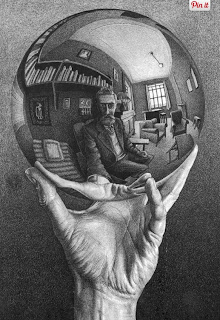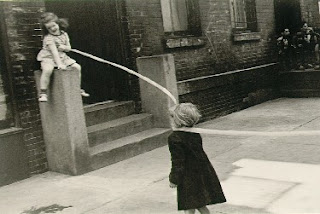Line- Lines are marks made by a pointed tool: brush, pencil, pen, etc. Lines can vary in width, direction, curvature, length, or color.
I chose this photograph for LINE because you can clearly see lines from the floor, curved and straight lines.
I chose this painting because you can see that almost everything is done with LINE, like the tall sculpts of rock.
Shape- Shapes are formed wherever the ends of a continuous line meet.Geometric shapes such as circles, triangles or squares have perfect, uniform measurements and don't often appear in nature. Organic shapes are associated with things from the natural world, like plants and animals.
I chose this photograph to represent SHAPE because you can see the geometric shape of a leaf, a continuous line.
I chose this painting because you can see the geometric SHAPE of the cans.
Color- Color wheels show the primary colors, secondary colors, and the tertiary (intermediate) colors. They also show the relationships between complementary colors across from each other, such as blue and orange; and analogous (similar or related) colors next to each other such as yellow, green, and blue. Black and white may be thought of as colors but, in fact, they are not. White light is the presence of all color; black is the absence of reflected light and therefore the absence of color.
I chose this photo for COLOR because you can obviously see color, it has the presence of warm and cool colors.
I chose this painting to represent COLOR because everything is has color, blue, yellow, green, red, and black, it contains most of the colors.
Value (Tone)- Value, or tone, refers to dark and light; the value scale refers to black and white with all gradations of gray in between. Value contrasts help us to see and understand a two-dimensional work of art.
I chose this photograph to show VALUE because of the different shades of black, you can see the color going from dark to light.
I chose this painting to show VALUE because its easy to see the color going from black to a lighter shade of black and gray.
Form- Form describes objects that are three-dimensional, having length, width, and height.
I chose this photograph to represent FORM because you can see that the squares are 3D, you can tell it has a length, width and height.
I chose this painting for FORM because you can see both man look like 3D.
Texture- Texture can be rough, bumpy, slick, scratchy, smooth, silky, soft, prickly--the list is endless. Texture refers to the surface quality, both simulated and actual, of artwork.
I chose this photograph for TEXTURE because when you look at it, you can imagine how the bark feels, you can feel the texture.
I chose this painting for TEXTURE because you can see the grass and almost feel the texture of ir.
Space- Space refers to distances or areas around, between, or within components of a piece. Space can be positive (white or light) or negative (black or dark), open or closed,shallow or deep, and two-dimensional or three-dimensional.
I chose this photo to show SPACE because you can see the straws been surrounded by negative(dark&black) shadows.
I chose this painting to represent PAINTING because the woman is surrounded by negative(black) space.
Balance is the comfortable or pleasing arrangement of things in art. There are three different types of balance: symmetrical, asymmetrical, and radial
.

I chose this photo for Balance because if you were to cut this photo in half it would be equal in both sides.
I chose this painting to show Balance because the total weight of the picture if balance.
Contrast-Contrast is created by using elements that conflict with one another. Often, contrast is created using complementary colors or extremely light and dark values. Contrast creates interest in a piece and often draws the eye to certain areas. It is used to make a painting look interesting.
I chose this photo to represent Contrast because the color of the green wall and the yellow dress conflict each other.It draws you attention to the little girl.
In this painting you attention is drawn to the flowers shown with color compare to thet guy in black and white thats holding the flowers.
Emphasis-Emphasis in the focal area of an artwork gives it importance. An artist may stress some elements of the design over others. The eye of the viewer will focus on the area of emphasis or center of interest first, then take in the rest of the composition.
I chose this photograph for Emphasis because the focal area is the red door, then your focus goes around the rest of the composition.
This painting shows Emphasis. The viewers attention is focused in the police man and the kid, then the attention goes to the rest of the painting.
Movement- Movement in an artwork means the artist is taking viewers on a trip through the work by means of lines, edges, shapes, and colors often leading to the focal area. Movement is a visual flow through the composition. It can be the suggestion of motion in a design as you move from object to object by way of placement and position. Directional movement can be created with a value pattern. It is with the placement of dark and light areas that you can move your attention through the format.
This photo represents Movement. The photo shows different dark and light areas that gets your attention throughout the whole thing.
Movement is presented here because the "head" shape repeated makes the viewers attention evaluate the whole painting.
Pattern- Patterns are made in art when the same shapes or elements are repeated again and again. Pattern uses the elements of art in planned or random repetitions to enhance surfaces of paintings or sculptures.
You can see Pattern in this photo, the yellow signs are been repeated.
This painting shows Pattern, the same people are been repeated over & over the painting.
Rhythm-RRhythm is the repetition of shapes, lines, and forms. Rhythm is a movement in which some elements recurs regularly. Like a dance, it will have a flow of objects that will seem to be like the beat of music.
This photo shows Rhythm, the repetition of the circle form and the lines of the mushrooms.
This shows Rhythm by repeating the square tiles, the statues, an lines on top of the painting.
Unity- Unity means that all elements in an artwork are in harmony. Unity brings together a composition with similar units.
This photo shows unity because the photo uses the same type of units.
This painting shows unity by having the same types of lines, the whole artwork is in harmony.
















































